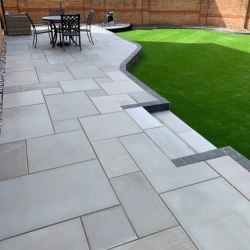0333 321 5091
01909 768 760
Mon - Fri 7:00 AM - 5:00 PM
Sat 8:00 AM - 2:00 PM

We Deliver
Nationwide
0333 321 5091
01909 768 760
Mon - Fri 7:00 AM - 5:00 PM
Sat 8:00 AM - 2:00 PM

We Deliver
Nationwide

At Paving Stones Direct, we get a lot of questions surrounding which paving option is the best, what is it like to keep them looking newer for longer and how easy is it to install them. This is especially true when people are looking to buy Sandstone paving stones. With that in mind, we decided to put together a top 10 list, tackling our most common questions we are asked.
This question is quite possibly the most common that we are asked surrounding sandstone slabs so we decided to tackle it first. The short answer is ‘Yes’, sandstone is good for paving. Here comes the longer answer. Sandstone is a very versatile option that has great strength and durability, and if you combine that with the natural array of colours and patterns that form over thousands of years, these qualities are perfect for choosing it as a paving option.
As noted above, sandstone paving is incredibly durable, this means it has a great amount of natural weather resistance. While it will absorb a small amount of water, this is something that can easily be reduced by adding a sealant to your sandstone paving once it has had time to dry and settle in it’s placement. This also means you do not have to worry too much about the slab changing its appearance when adverse weather hits.
This is a question that is quite often asked and one that often surprises our customers when we give the explanation. Sandstone paving isn’t slippery when hit with bad weather as long as you help maintain it. Due to its natural origin, it has a degree of slip resistance and if coupled with a riven finish, this provides a huge amount of slip resistance. If no maintenance is given to the paving, then over time, moss and algae may start to develop on the surface, removing the natural slip resistance until proper care is given.
If sandstone is hit by the colder variant of the great British weather, then these slabs are able to hold their own but if the paving is hit with direct sunlight for prolonged periods of time, the sandstone will begin to slowly fade. While initially, this may seem like a negative aspect to this paving option, the opposite is actually true. The subtle faded effect that begins to display on the surface actually adds character to your patio and can start to display a look that is both charming and appealing.
Sandstone is one of the tougher stones that you can use for your paving needs but that doesn't mean it can be neglected. Simply giving them a sweep down and hosing them down at least once a month will help remove any dirt and grime build ups, this helps to keep the paving at an easier manageable maintenance level. To make maintenance even easier, you can also opts to invest in some aftercare products that add an extra layer of protection.
This is a question that is hotly debated within the landscaping community so unfortunately, there isn't a definitive answer for this. While many landscapers will state that using a sealant will help to protect them, others are in the opposite camp with claims that sealant initially damages the sandstone paving. The best thing to do in this situation is to discuss your options with your landscaper and decide what will be best for your patio.
If you unfortunately stain your paving, you may be of the opinion that you will be required to replace the entire slab but fortunately, that is not the case. If the stain in question isn’t too tough, warm soapy water will do the trick but for tougher stains, you may need to resort to something stronger such as a bleach mixture made up of exile parts water to bleach. Just remember that if you are using a stronger solution, only leave the mixture on the paving slab for a maximum of 30 mins and then rinse thoroughly.
One of the best features about sandstone slabs are the different finishes that are available. There are 2 common finishes that can be found with sandstone paving, smooth and riven.
Smooth - Smooth finish paving has been machine worked once split for the main paving rock. Great for display areas that do not see a lot of foot fall.
Riven - When the slab is split from the main paving rock, this often leaves ridges in the surface of the paving. This is the riven texture. Perfect for outdoor use and areas that receive a lot of foot traffic.
These different types of finishes give sandstone paving an added layer of flexibility, allowing you to choose the best option for your patio garden.
It will come as no surprise that there is a fantastic selection of colours available for sandstone paving such as the traditional looking sawn mint which blends multiple light tones together to create a warm summer feeling or the more neutral looking sawn grey sandstone which showcases multiple grey tones. If you prefer a ‘sunset’ look, then the darker tones autumn blend is sure to catch your attention. The amazing thing about these colours is, they have all formed naturally over thousands of years so it is easy to see why they add an incredible amount of character to any garden patio.
This question isn’t as simple to answer as some of others due to multiple factors attributing to the lifespan of sandstone paving such as -
Installation - This is quite possibly one of the most defining factors which contributes to the lifespan of sandstone slabs. If the paving is installed correctly, it will last for a very long time, sometimes upwards of 25+ years, but the opposite is true for poorly installed sandstone paving. If installed incorrectly, you may only receive between 2 to 10 years.
Maintenance - As mentioned above, correctly maintaining your paving will help keep the paving looking new and fresh for longer. This in turn contributes to the health of the slab, meaning it will last longer.
Usage - This is quite possibly very obvious but needs to be highlighted. If the paving gets A LOT of usage, it will wear quicker than if it receives very little usage.
There are multiple grey shades available when choosing sandstone paving but we often get asked about Kandla grey and what it is specifically. Kandla is an area of India where the grey sandstone is quarried. For this reason, the grey sandstone from this area is often called Kandla grey.
This concluded our 10 questions about sandstone paving (and one bonus point). Hopefully this will help to shed some light on this incredibly beautiful and versatile paving and help you decide if it is right for you. Need any advice regarding Sandstone paving, How to lay sandstone paving or anything paving related?, please do not hesitate to contact us either by phone or drop us an email on sales@pavingstones.co.uk.
Note - Information provided to be used as a guide only. Please contact a trained and informed professional for any guidance regarding sandstone paving and the installation of sandstone paving slabs.